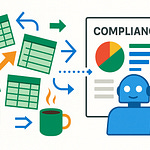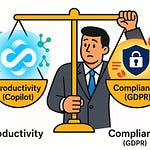Here’s the shocking truth: most professionals using Microsoft 365 Copilot are barely scratching 10% of its potential. And that wasted value? It’s the difference between covering your license cost or throwing money into the wind. Today, I’m exposing the exact 10 prompts I rely on daily that make Copilot not just a cool add-on, but a real ROI driver.
The Hidden Cost of Daily Productivity Roadblocks
What if the real drain on your productivity isn’t the amount of work on your plate, but how you handle the routine tasks that sneak into every single day? It sounds minor at first—just a few extra minutes here and there—but those minutes rarely stay contained. They expand, stack up, and compound until they quietly consume hours you never planned to lose. And the real kicker? Almost none of it qualifies as the kind of work that moves projects forward or creates value. It’s the digital equivalent of getting stuck in quicksand before you even start moving.
Think about the first touchpoint most of us face every morning: the inbox. A hundred unread emails, most of them irrelevant, a handful needing immediate replies, and a dozen more requesting your attention at some point later. By the time you finish skimming, flagging, deleting, or drafting answers, an entire hour of peak focus is gone—and you haven’t even touched the work you came in to do. That tiny mountain of micro-decisions hijacks the start of your day before you realize what’s happening. The problem is not that email exists; the problem is that the process of wrangling it still looks like it did ten years ago.
The irony here is that Microsoft 365 is loaded with every imaginable communication and collaboration tool, from Teams to OneNote to SharePoint. It promises integration, context, and automation. Yet, in practical reality, most professionals admit they spend more time bouncing between apps than getting value out of them. Tools are abundant, but the way we interact with them often locks us in workflows that are heavier, not lighter. You prepare slides in PowerPoint, then jump over to Excel for stats, then switch to Outlook to clarify an email, and somewhere in the process you begin writing notes by hand just to keep track of who said what. That isn’t productivity; that’s tool fatigue.
I want you to picture a Monday morning that looks very normal. You arrive, coffee in hand, open Outlook, and there it is: the familiar wall of unread emails. Let’s say it’s 8:45. By 9:30, you’ve sorted through them and maybe replied to five. Calls are starting at 9:45, so you hastily jot down a few notes for the next meeting, already feeling behind. The morning has vanished and not one piece of real project work has even started. For many people, this rhythm repeats itself every morning of the workweek. That’s five hours gone—half a full workday—without delivering anything tangible.
Research has consistently shown this isn’t an exaggeration. Business professionals spend a striking portion of their schedule on email management and post-meeting follow-ups. Add all that time together and you find that the “work about work” is starting to outweigh the work itself. This is why so many people feel like they’re constantly busy but making slow progress. The two-hour meeting hangover, the endless inbox spring cleaning, the ritual of reorganizing a PowerPoint deck—all of these tasks nibble away energy incrementally.
It’s like ignoring a leaky faucet at home. Each drop by itself doesn’t seem to matter. But run that drip day and night for a month, and suddenly you’ve lost buckets of water. Productivity works the same way. The little leaks in how you manage everyday tasks are cheap in the moment, but expensive when measured across weeks and months. And unlike a faucet, where the leak is visible, these leaks are hidden in plain sight inside your digital checklist. If you don’t plug them, they’ll keep running silently.
That’s where the right category of prompts in Copilot becomes interesting. Not as some shiny trick, but as a tool aimed directly at those hidden leaks. It isn’t promising to change what your work is, it’s promising to alter how you get into it without bleeding that upfront time cost. A well-phrased request to Copilot can strip an hour-long grind down to a few focused minutes. For email, meetings, or document prep, it’s less about novelty and more about reclaiming those lost drips of time before they flood the day.
This is why Copilot doesn’t land as a gimmick when deployed correctly. It behaves more like an assistant that sits quietly in the background until you need a shortcut through the roadblocks. Once you see it that way, the license isn’t an expense to debate—it’s a trade-off. You’re buying back the hours you were already losing to inefficiency. That’s the return on investment most overlook, because it isn’t abstract: it’s hiding right inside the bottlenecks you’ve normalized as “just part of the job.”
And the first bottleneck worth tackling is one nearly everyone recognizes—email chaos. If your ROI is dripping away somewhere, this is where the faucet is running wide open.
Turning Email Chaos into a 5-Minute Task
If your inbox has ever felt like a second full-time job, you’re not alone. For most knowledge workers, the day doesn’t really begin with project work or decision-making—it starts with a never-ending stream of unread messages. The irony is that none of us signed up for “email manager” as a core job title, yet that routine overhead keeps stealing our best focus hours before we even touch meaningful tasks. If ROI leaks are hiding anywhere in your workflow, chances are they’re dripping straight out of your Outlook inbox.
Let’s be honest—those morning sessions of sorting, replying, and flagging priority emails rarely feel like productive time. You’re trying to pluck a handful of critical updates out of the noise, but instead, you play referee between newsletters, status reports, meeting invites, and requests labeled “urgent.” Even if you’ve spent time setting up rules, folders, or categories, your brain still carries the load of evaluating and sorting. That’s the invisible cost: not the few seconds it takes to delete a message, but the constant micro-calculations. Each decision chips away at the mental bandwidth you were supposed to save for actual work.
The traditional tools don’t help much here. Filters keep your inbox tidy, sure, but they don’t reduce the effort of figuring out what matters most right now. And while flags or color-coding add structure, they’re still putting the sorting job right back on you. What all of that misses is the exhaustion that builds when you skim hundreds of subject lines, click in and out of threads, and weigh whether to reply immediately or save something for later. The act of triage becomes the hidden tax. Multiply that across every day of the week and the waste is obvious—it’s a job within the job.
Now think about a realistic scenario: you start the morning with 200 unread emails waiting for you. Out of those, maybe ten are important, twenty need follow-ups eventually, and the rest are background noise. But before you find the ones that matter, you’ve clicked through dozens of irrelevant threads. You open, skim, sigh, delete, move on, repeat. Before you know it, 45 minutes are gone—and the “real work” still hasn’t started. This is the classic trap where busyness masquerades as productivity. The time disappears, but the output at the end feels empty.
This is the exact point where Copilot shifts the equation. Instead of forcing yourself through every message, you can simply ask it to review the inbox on your behalf and present only what matters. Copilot doesn’t just list unread items; it organizes them into what demands action now, what’s background information you can skim later, and what you could safely ignore. It also adapts based on your writing style and tone, meaning the replies it drafts will already read like you, not like a robot sending canned messages. That eliminates one more mental hop—the energy of rewording and editing isn’t needed.
One of my go-to prompts here is incredibly straightforward: “Summarize my new emails into two lines with today’s top priorities.” In seconds, I’ve got a high-level recap telling me what decisions need to be made and what updates I should be aware of. It doesn’t replace every detail, but it immediately cuts down the noise so I can engage with the important threads first. The result is that the inbox doesn’t dominate the morning; it becomes a brief pit stop before moving into actual work.
The convenience is nice, but the real value is larger—it sets the tone for the whole day. By not losing an hour before 10 a.m., every task that follows benefits. You start project work with more clarity, you approach meetings with less stress, and you’re already working on something valuable before most people are still wrestling with half their inbox. That’s how the ROI equation begins paying off early. Just reclaiming that first hour means you’ve already neutralized one of the biggest daily drains, and you’ll feel that compounding effect across the rest of your schedule.
This is why small, well-worded prompts can create such an outsized impact. The payback isn’t abstract—you can measure it directly by the minutes saved in mornings where your inbox doesn’t hijack the agenda. Freeing that time changes the rhythm of the entire day. And while email chaos might top the list of drains, it’s certainly not alone. The next major sinkhole for most professionals happens the moment you join meeting after meeting, and instead of closing gaps, you’re left with more work summarizing what happened than the actual call itself. That’s the next leak we need to fix.
Meetings Without the Hangover
What if you could walk out of every meeting with perfect clarity and a full list of outcomes, without typing a single line of notes? For most of us that sounds like wishful thinking. The weight of meetings doesn’t just come from attending them, it comes after. You leave one call only to spend the next 30 minutes rewriting your scribbled notes into something shareable. Then you’re messaging colleagues to confirm what was actually agreed upon because half of it was said in passing. Before you know it, the calendar block for the meeting has doubled, and the work still isn’t moving forward.
Meeting fatigue is real, and it builds in layers we don’t often notice. You think the main drain is sitting through the call itself, but the hidden cost shows up later. Remembering action items, clarifying who owns which task, and following up with people who weren’t there adds another dimension. It isn’t the conversation itself that wears you down, it’s the administrative shadow it casts afterward. And that’s assuming you even remembered the details correctly. By the end of the week, half of what was said has blurred together in a fog of generic talking points. The few actual decisions made get buried because memory alone isn’t a reliable system.
We’ve all seen that project lead struggling through three back-to-back Teams meetings on a Tuesday morning. Picture it: the first one runs five minutes over, the second starts with a quick round of small talk that drags on, and the third derails into a side discussion that should have been an email. After all that, instead of diving into project work, they spend yet another hour typing up rough summaries, scanning the chat logs for missed points, and trying to extract who volunteered for what. By lunch, they’ve invested four hours and have little more than a vague sense of group consensus. That’s the modern meeting hangover.
Here’s where Copilot changes the rhythm. Instead of you chasing fragments of information, its prompts transform what’s said in the meeting into structured outcomes. This isn’t just a transcript you’ll never read. It’s clarity—decisions framed as bullet points, action items tied to specific names, and risks flagged upfront. Rather than combing through lines of “discussion,” you walk away with a playbook ready to hand off to the team. That shift alone means the meeting stops being a sinkhole and starts acting as a launchpad for execution.
One simple but powerful prompt I often suggest is this: “List the five key decisions, five action items with owners, and outstanding risks from the meeting.” In under a minute, you move from raw conversation to a working plan. If that meeting was originally a chain of loose dialogue, you’ve just turned it into a checklist that drives momentum. Compare that to an hour-long slog typing the same points manually—it’s obvious where the return comes from.
This approach does more than keep your notes tidy. It resets expectations for what meetings are supposed to produce. Instead of walking out wondering who was responsible for a deadline, you see it in writing with their name attached. Instead of scheduling a follow-up chat to agree on decisions everyone thought they made, you’ve got them captured and locked before memory fades. That eliminates the back-and-forth correction cycle that wastes time long after the meeting ends.
The value becomes visible the first time you cut a 60-minute summary process down to a 30-second output. That gap isn’t marginal—it’s transformational. Multiply it across every standing meeting, every project sync, every steering committee call, and suddenly you’ve reclaimed hours each week that used to vanish into tidy-up work. It’s a reallocation of time from documentation back to execution. And when you experience it firsthand, that’s when the license stops feeling like a cost and starts feeling like part of your core toolkit.
Professional life isn’t going to shed meetings anytime soon. But reshaping what happens after them is possible. With Copilot aligning decisions, tasks, and risks into structured clarity, the hangover effect disappears. Instead of drowning in notes, you leave with outcomes in hand. And once you’ve broken free of the cycle of wasted hours after meetings, the next logical step is to look at another source of lost time—wrestling with spreadsheets when you really need quick insights to make fast, data-driven choices.
From Spreadsheet Wrestling to Instant Insights
How many hours have you lost fighting with Excel formulas that refuse to work the first time? You know the feeling—you write the formula, run it, and instead of clean results you get an error message or, worse, numbers that don’t make sense. You sit back, tweak references, test again, and wonder why “sumifs” or “vlookups” feel like they’re fighting back rather than doing the work for you. By the end, you’ve spent so much energy on syntax that the insight you were chasing starts to feel secondary. And let’s be real, Excel isn’t optional. At some point, whether you deal with finance, marketing, or project data, you’re going to end up in a spreadsheet.
The pressure adds another layer. Maybe you’ve been asked for a pivot table by your manager just an hour before a leadership update. Or you’re the unlucky one tasked with creating a year-over-year forecast for next week’s strategy session. These aren’t nice-to-have charts—they drive decisions. The problem is, most people aren’t data analysts. They know enough to get through formulas and maybe adjust charts, but when time pressure stacks on top of limited technical skill, the process slows to a crawl. That’s the hidden roadblock. It’s not that the data isn’t valuable, it’s that the manual steps to shape it into something useful act like handcuffs.
Picture a real scenario. A sales manager exports raw numbers from the CRM. It’s messy: thousands of rows, random formatting, missing headers. The assignment is simple on paper: create a clear report showing churn trends in the last three quarters. But what happens? Half the day drips away cleaning up columns, aligning dates, creating calculated fields, and building pivot tables just to reach a baseline where analysis is even possible. At that point, mental fatigue has set in and the actual meaningful step—interpreting what the numbers mean—gets rushed. This is the spreadsheet wrestling match most professionals know too well.
Where Copilot shifts things is in removing the friction. Instead of starting with formatting gymnastics, you can prompt Copilot to standardize, clean, and organize raw data for you. More importantly, it goes beyond calculations. If you ask for patterns or anomalies, it doesn’t just build a chart—it interprets the results with context. That’s the meaningful difference. You’re not just handed another pivot table, you’re handed an explanation that tells you what the pivot actually means for your business question. It bridges the gap between having numbers in a table and walking into a meeting prepared to talk about what they imply.
Here’s a prompt I recommend starting with: “Analyze the churn data for the last three quarters, surface unusual patterns, and suggest three possible reasons with context.” With one directive, you skip the clutter of data prep work. Instead of staring at 5,000 rows, you get a summary telling you where customer losses are spiking, when the trend started, and which variables—like pricing changes or seasonality—may be influencing the story. What normally takes half a day of manual pull-and-push inside Excel turns into minutes of high-level understanding.
This is where things quietly move beyond saving time. Manual analysis requires constant human eyeballs scanning for patterns, which means errors slip in easily. A misplaced formula, a filter applied wrong, or data copied one cell off can flip an entire conclusion. Copilot reduces that weakness. Because it works at the interpretation level, it’s less about recreating charts you might design yourself and more about surfacing signals without the human error baked in. That not only gives speed—it improves the quality of the decisions that come out of the analysis.
Imagine the contrast for a leader preparing for an executive briefing. In the old model, half a day dissolves inside Excel trying to prep the data. By the time the graphs look clean, you barely have breathing room to think about their meaning. With Copilot, the room for error shrinks, insight arrives sooner, and you walk into the meeting already equipped to make sense of the data rather than defending your pivot table construction. The leverage here isn’t just in minutes saved—it’s in how much sharper and faster your decisions become because the grunt work disappeared.
And that’s an important shift in the ROI picture. Up to this point, we’ve talked about reclaiming wasted time in tasks like email and meetings. But when Copilot starts shaping raw data into actionable narratives, you aren’t just saving time—you’re changing the quality of decision-making. That moves ROI from being about hours back on your calendar to being about competitive advantage. It’s time given back, yes, but also clarity delivered at exactly the moment you need it.
Once you see that pattern, the next logical step is to stop viewing these prompts as isolated tricks. The real magic happens when you connect them across the whole Microsoft 365 stack, turning them into workflows that stitch together your most common tasks. That’s where the exponential payoff really begins.
Workflows That Pay for Themselves
The real ROI story with Copilot isn’t just about shaving minutes off your email routine or creating faster meeting notes. Those wins are useful, but the real momentum starts when those prompts stop being isolated hacks and start working as part of connected workflows. That’s when you see exponential returns. If you think about it, saving 15 minutes here and 30 minutes there looks good on paper, but the real value comes when you never have to stop moving between apps. Instead of bouncing from Teams to Word to Excel and back again, Copilot does the transitions for you, using context you’ve already built up in one place and carrying it into the next without friction.
Most people never get to this point because they treat each Copilot action as a single-use benefit. Summarize this inbox. Draft that meeting recap. Build one chart. It stays boxed in. The trick most miss is that those outputs can flow forward, feeding into the next step automatically. It’s like comparing single notes to a chord. A one-off prompt gives you something nice and quick. Chaining those prompts across your Microsoft 365 workflow builds something bigger, the kind of productivity rhythm where you stay focused on the work instead of the navigation.
Take a common scenario. You’ve got a project plan built out in Excel—resource allocations, milestones, deadlines, the usual. Normally, your next steps would involve exporting parts of that data into Word to prepare a leadership update, then hopping into Outlook to send the file out, and then making a calendar note or Planner task to track the next update cycle. That’s at least three context shifts, each one requiring some copy-paste gymnastics and a few minutes of mental reset. What feels like simple “handoff work” slowly adds up until you’ve lost an hour stitching things together.
With Copilot, chaining prompts means you can ask it: “Take the current project plan in Excel, draft a leadership summary in Word, send it as a polished update via Outlook, and prepare a message in Teams for the project channel.” Instead of four disconnected steps, you get one continuous loop. Copilot acts like the glue across the apps, using the context in your data to populate summaries, shape them into documents, and push them into the right communication channel while you stay out of the weeds. It’s not just faster—it removes the fragmentation that makes work feel heavier than it really is.
Here’s the insight most people miss: Copilot doesn’t just save time in fragments, it compounds the effect the moment continuity is added. Think about the mental bandwidth you normally spend switching gears. Each time you leave one app for another, even if it’s just thirty seconds, there’s a small cognitive cost to remembering where you were. Multiply that across ten or fifteen context switches a day and the number gets serious. But when Copilot handles the transitions, your mental energy remains on the actual content, not the logistics. That’s why workflows are the tipping point between convenience and transformational ROI.
Now, when you look at value through this lens, the math shifts. Up to now, you’ve probably thought of Copilot’s ROI in hours saved. If you rescue two hours of admin time a day, you can map that to the cost of the license. That’s helpful but limited. At the workflow level, the ROI isn’t hours—it’s outcomes accelerated. Because when updates, reports, and follow-ups stitch together seamlessly, projects don’t just run more efficiently, they move faster toward delivery. A week shaved off reporting cycles or project updates is a different level of value compared to adding up reclaimed minutes.
This is the stage where the license cost starts to look small. It’s no longer about whether you can “break even” by saving an hour a day. You stop running the math, because the efficiency gains come not only from minutes returned to your calendar but from momentum across the business. Work stops feeling like broken pieces of admin scattered in different apps and more like one continuous, connected thread. The outcomes become visible—not just less wasted time, but entire tasks resolved without you touching each piece along the way.
That’s the mini-payoff most people don’t see until they start chaining prompts. ROI isn’t just the total of saved hours anymore—it’s the leverage you create when your tools aren’t pulling you in different directions. Once you’ve seen it play out, it’s hard to go back to running Microsoft 365 as a collection of silos. The natural next question then becomes: how exactly do you measure the point where Copilot has already paid for itself? That’s where the ROI equation gets interesting.
Conclusion
The real measure of Copilot’s ROI isn’t the subscription price—it’s whether you stop losing time on tasks that should never take as long as they do. Email triage, meeting recaps, spreadsheet cleanups—those aren’t where your value lies. They’re just friction points that quietly drain attention and energy.
So here’s the challenge: pick your single biggest daily roadblock, frame it into a simple prompt, and run it through Copilot tomorrow. Watch the difference when it clears the path. Because once AI isn’t just trimming minutes but reshaping the way your workflow connects, that’s when the real impact begins.











